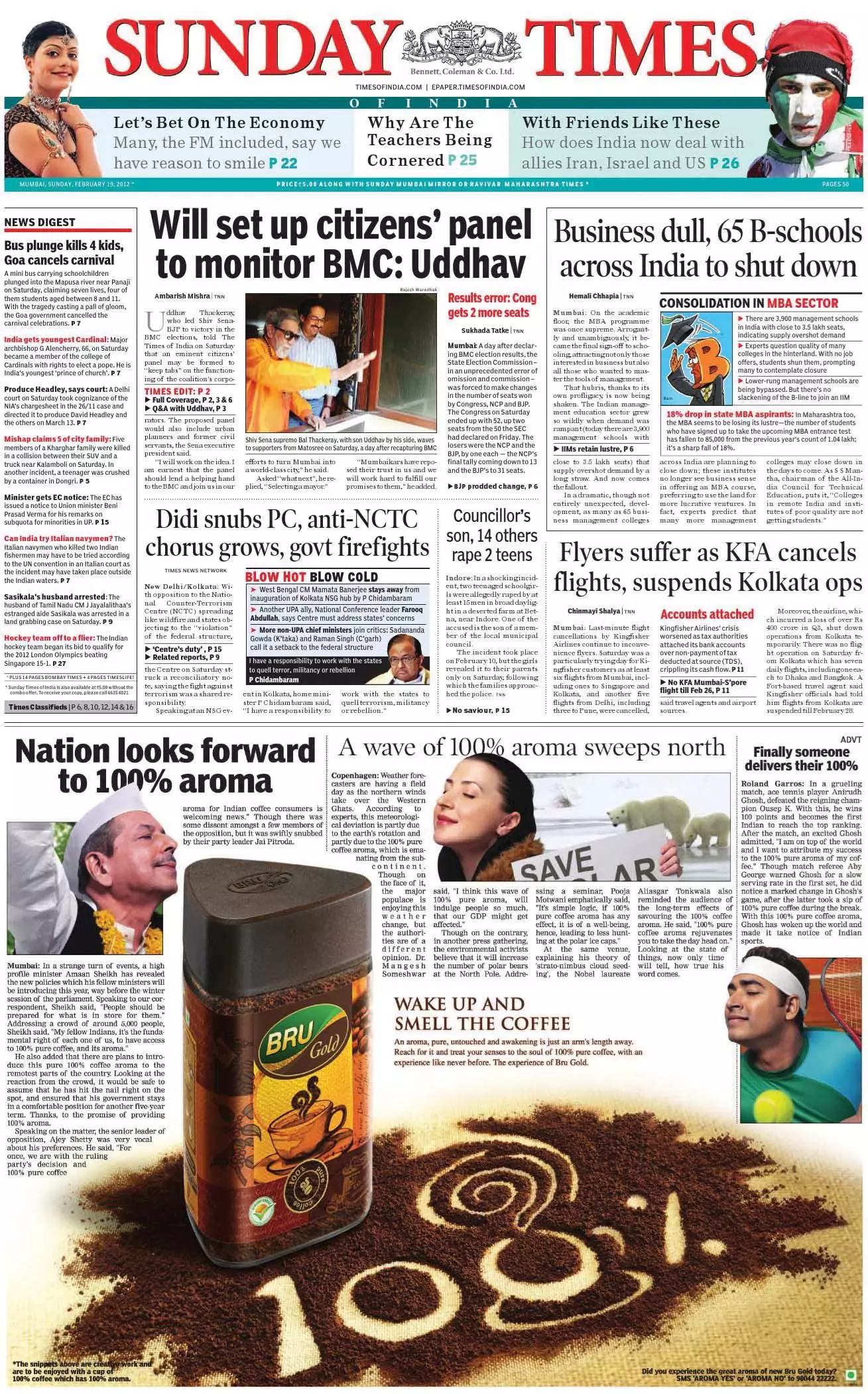Print medium gives advertisers access to an audience that can genuinely be engaged. Therefore, it is imperative to create print communication that is truly clutter-breaking. We take a look at the print advertising innovations space in India where a lot has been brewing since the last few years.
In the cold winter mornings of Delhi, one of my most favourite things to do is to grab the morning newspaper and a large mug brimming with black coffee, and head to my serene terrace. Those 20-25 minutes that I spend up there sort of prepared me to face any mayhem that the rest of the day can possibly bring forth.
Reading something in print – anything from a book to a magazine to a newspaper – has always been a personal act, and it becomes even more personal amidst the largely social event of watching television or browsing and constantly sharing on the internet. I feel it’s the only time when at least I can cut off from various varieties of cacophony and solely concentrate on the rhythm of something.
Well, the point is that print holds a lot of power. The moment advertisers, or even editorial people, are stuffing print with useless junk, they are probably highly underestimating what they are losing out on - an audience that can genuinely be engaged. Therefore, in the most simplistic and clichéd advertising term, print advertising really needs to be clutter-breaking. As Naresh Gupta, chief strategy officer and managing partner at ad agency Bang in the Middle says, “The role of print in overall communication mix has changed. It retains the ability to be impactful, involving, and something that builds immediacy for purchase. Innovation in print is needed to achieve either greater impact or immediate action. Both can’t be achieved through any other medium.”
In the last few years, we have seen many “print innovations” in India and globally. Some have been outstanding. Some have been inspiring. Some have been worth talking about. Some have led to wildly mixed reactions. And some have been purely cringe worthy.
Almost every one of you would remember the times when Volkswagen gave us our talking newspaper and then the vibrating newspaper. Or when Bru Gold made us sniff our morning papers that were infused with the aroma of coffee. Nescafe, another coffee brand, turned the daily newspaper into a pop-up café which surprised the readers with two foldable cups along with sachets of instant coffee that only needed some hot water. Kissan sauces had us pluck out a small of packet of tomato seeds from our newspapers. Tata Motors neatly tucked a bar-coded key in a four page advertorial supplement so that we get tempted to go for a test drive of its brand Zest. Kajaria tiles placed a pair of 3D glasses for the viewing of their 3D print ad to promote their 3D tiles collection.
Then there was the night paper that Colgate came up with Telugu newspaper Sakshi (based in Andhra Pradesh) to spread a word about dental hygiene before one goes to bed. QR codes embedded in print advertising, that can take the reader to its related digital platform when scanned with a phone, had been rampant at one point. Now there is a lot happening in the Augmented Reality space, something we covered extensively in the December issue of PrintWeek India.
Two for the coffee lovers: Bru Gold made us sniff our morning papers that were infused with the aroma of coffee. Nescafe turned the daily newspaper into a pop-up café with two foldable cups and sachets of instant coffee. Coffee, coffee, coffee!
Innovation, when it comes to print advertising in newspapers or magazines, is tough to hold down in watertight compartments. Innovation could just be a good creative or it could stretch in terms of the material, printing, placement or integrating itself with digital, among other things. The underlying idea needs to be the same though. The advertisers need to have engaging and meaningful conversations with the readers. It’s as simple and as obvious as that.
It also has to do a lot in terms of what a brand wants to really achieve. For Motorola India, for example, digital remains the sales model and the primary form of communicating to its target audience. The brand is quite clear about leveraging print effectively for new launches though.
Rachna Lather, marketing head, Motorola India, says, “Newspapers are the best way to announce something new. Depending on the product that’s getting launched, we either keep it limited to certain kind of publications, or we go all out. For more affordable handsets, we go with almost all publications including the regional language dailies and for high-end stuff, we restrict it to the English dailies. In terms of the format, we stick to a large format and use vibrant colours to be more impactful and to go with the youthful image of our brand.”
Newspapers are the best way to announce something new.We stick to a large format and use vibrant colors to be more impactful and to go with the youthful image of our brand
Rachna Lather,
Motorola India
Take your pick: Motorola placed an interactive ad in Wired magazine. The readers in the US could click buttons to see Moto X in different colours
Lather also mentions in the conversation that the brand is now gearing up to create some print innovations for the Indian market as they have done internationally. In 2013, Motorola placed a much talked about interactive ad in the international Wired magazine where the readers in the US could click buttons to see Moto X in different colours.
How do you make sure that the print innovation is actually meaningful and not just something to create a buzz? Is there a rule of thumb, I ask Lather. She explains, “We make sure that when it comes to doing innovation in print, the innovation depicts the product’s USP clearly. It has to demonstrate what the product, and the brand, is all about. It just cannot be there for the heck of it. For example, sometime back there was this brand which had done a foil printed ad in a newspaper which had absolutely nothing to do with the brand. The sole purpose was to grab eyeballs. How does that make sense?”
In terms of the integration between digital and print to drive innovation, Lather has her reservations about it. She feels that mainly any innovation that requires an extra effort from the readers can have a slow success rate. She believes that anything that can be seamlessly integrated works much better. Interestingly, even Gupta of Bang in the Middle feels that the integration of print and digital has not really picked up in India, or rather implemented in India.
“Some brands have tried to put a QR code to launch mobile site, or the likes of Volkswagen which put an audio chip. Some brands place a hashtag to make the conversation ‘digital’, but by not making the entire content on social feed in tune with print they lose on the overall impact. There are many ways by which print and digital can interact, but that has not become an everyday thing and I can’t remember a brand that really integrated the two,” he says.
At many touch points: Coca Cola and White Print, the Braille lifestyle magazine, went back in time to cater to the visually impaired population of the country and created a musical greeting card. And then they made merry with‘Ummeedo waali dhoop, sunshine waali asha’, the brand song.
Another area which advertisers must sit up and take notice is the slow but strong proliferation of niche magazines which can be leveraged in unique ways when it comes to communication. Of course, we have always had premium magazines that can be leveraged to target that particular audience. However, we now have many independent magazines that are catering to highly specific niches like design, LGBT and visually impaired, among others. The example of White Print magazine and Coca Cola’s simple collaboration says a great deal about this. White Print is India’s first lifestyle magazine in Braille that was launched in 2013 to cater to the visually impaired population of the country. The magazine and Coca Cola went back in time to create an ad for the brand that’s akin to a musical greeting card. Instead of doing a text-based ad, Coca Cola put a musical chip in the centre of the magazine that played the whole brand song ‘Ummeedo waali dhoop, sunshine waali asha’ when the reader opened that particular page.
Upasana Makati, founder and editor of White Print says, “The most interesting aspect of the ad was the response from the readers. For them, Coca Cola became a company that was actually trying to innovate for them, and they got terribly excited about it. It worked well for Coca Cola as that target audience finally could associate the jingle with the brand. They even received an award for it at Goafest last year.” While sound based ads is one form of innovation, White Print is also exploring tactile images, so that the shapes can be felt by visually impaired people. The magazine is also up for collaborating with brands to create 3D printing based innovations.
There are many ways by which print and digital can interact. And I can’t remember a brand that really integrated the two
Naresh Gupta,
Bang in the Middle
Minimal gimmick, maximal impact: All that Apple’s Think Different campaign had was an image, the two-word tagline, and the Apple logo in colour. And here we are...
Of course, as mentioned earlier, technology is not the only way to drive innovation. Sometimes a cleverly placed ad can do that. Sometimes, a brilliantly crafted long copy can do that. Sometimes a good old musical chip can do that. Sometimes even simplicity that stands out can do that. Who
can ever forget those striking black and white print ads for Apple’s Think Different campaign where there were no computers and no copy? Just an image, the two-word tagline, and the Apple logo in colour.
Basically, when I and a million others are spending some quality time with their daily newspaper and morning cuppa, the advertisers simply cannot bombard us with cluttered and haphazard patches of communication. Not only will we consciously ignore it, but it might also leave a negative image of their brand in our heads. What they can do instead is politely and creatively draw our attention to what they have to say, and engage us in a truly creative way. That would be the perfect beginning of the relationship of their brand with us, the readers.

















 See All
See All